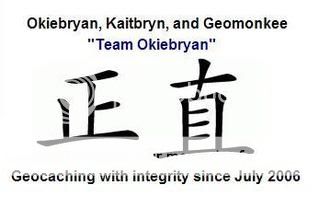An Historical Crossroads Traditional Cache
-
Difficulty:
-

-
Terrain:
-

Size:  (regular)
(regular)
Please note Use of geocaching.com services is subject to the terms and conditions
in our disclaimer.
You are looking for a camo'd lock and lock, very well hidden. This
one may be a challenge for you. Be sure to park at the boat marina
at N35 16.650 W095 33.219 and walk straight to the cache so that
you won't be crossing any private property.
Less than a mile northeast of here, and under 50-60 feet of water,
is the location of North Fork Town. The town was in sections 5 and
6 of T9N, R17E.
North Fork Town was considered the crossroads point of the Creek
Nation. The journals of Spanish Conquistadors described crossing a
confluence of 2 large rivers in this area in the 1600s. Their
sketches and decriptions match the topograpy of this area. French
trappers had trails along the Canadian and the North Canadian
during the 1700s when the fur trade flourished, and noted evidence
of the Spaniards passing this way 100 years earlier. Soon after the
purchase of the Louisiana Territory by the United States, a trail
used earlier by the Osage Indians but later known as the "Texas
Trail" linked towns in Missouri with those in Texas. In this area
North Fork Town developed, and the Creek Trail of Tears
ended.
In 1823 a trading post was started near the location, but it only
lasted a few months. In 1830, when the Creeks began moving into the
fertile valleys of the confluence of the Canadian and North
Canadian rivers, permanent stores, blacksmith shops, and several
homes - mostly log cabins - were built. In 1839 Josiah Gregg, noted
for his development of the Santa Fe Trail, laid out the Gregg Trail
from Webbers Falls through North Fork Town to Edward's Post and
westward. In 1849 migrants on the way to western gold fields
followed Marcy's California Road past North Fork Town. In the
article "Ghost Towns and Old Roads" (Daily Oklahoman, February 14,
1937, p. 12D) Grant Foreman wrote:
Long teams of four to six spans of oxen under the blows and
imprecations of their drivers, strained and struggled to pull
loaded wagons through the deep mud of springtime. They were part of
the trek of hopeful California emigrants on the way through Indian
Territory in 1849. Arrived at North Fork Town, many of them eagerly
embraced the opportunity to exchange their heavy wagons with the
Creek Indians for ponies on which they loaded their most essential
belongings. These Indians thus became the owners of more good
wagons than they had ever dreamed of possessing.
In 1849 the Methodists built a large school, called Asbury Mission,
near North Fork Town. The main building was a large, three story
brick structure 110 feet long by 34 feet wide. It also had a
basement. There were nearly 100 students enrolled when the school
opened in 1850. The school was of such importance that it became
the cultural center of community life. The post office, then named
Micco, was established in 1853. The school was later destroyed by
fire.
During the Civil War, North Fork Town served as a supply base for
the Confederate army, especially during the more northern
operations. The battle of Honey Springs was fought about 18 miles
north of here in July of 1863. Because of bad weather and wet
Confederate gunpowder, this battle proved to be a decisive defeat
for the Confederate forces in Indian Territory.
In 1871-1872, when the Missouri, Kansas and Texas Railroad was
building through the Indian Nations from Kansas to Texas, the
tracks missed North Fork Town about 2 miles to the west. Several
merchants raised a fund of 500 dollars and gave it to the railroad
to build a depot at the place that later became the Town of
Eufaula. As a result, most of the business people moved to the new
town, and North Fork Town ceased to exist as a business
center.
In 1963, when Lake Eufaula was impounded by the Army Corps of
Engineers, the site of North Fork Town was covered by water, never
to be seen again. The few homes remaining in the area and the
cemetery were moved to Eufaula.
Much of the story of North Fork Town came from the book, "Ghost
Towns of Oklahoma", John W. Morris, 1978, University of Oklahoma
Press.
Thanks to Joytoy1963 for helping me hide this cache! What a fun
time!


Additional Hints
(No hints available.)